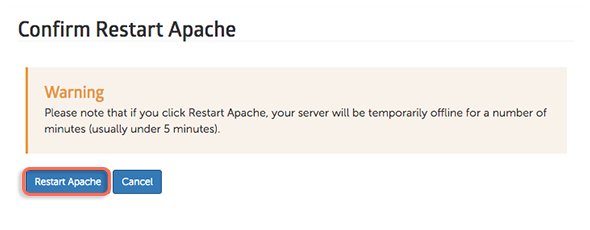
- AMPPS APACHE HAS TO BE RESTARTED HOW TO
- AMPPS APACHE HAS TO BE RESTARTED 64 BIT
- AMPPS APACHE HAS TO BE RESTARTED UPDATE
This command must be preceded by a PORT or PASV command. If the file does not already exist, it is created. Server Replies 202 Command ACCT not implemented.Īppends data to the end of a file on the remote host. Server Replies 226 ABOR command successful. ABORĪborts the previous FTP service command and any associated transfer of data. For now, I think it's better to try the default version and play with the new PHP features.This document describes all the FTP commands implemented.
AMPPS APACHE HAS TO BE RESTARTED UPDATE
You can check any update for new PHP 7 build and versions and see if you can update the 7th version. Conclusionsįinally, PHP7 is working and I am happy. If you have a 404 error, remember to start Apache and MySQL from the Ampps control panel. If you access your browser, you will have the access to the Softaculous web interface where you can make all operations. # Stop Ampps Apachesudo /usr/local/ampps/apache/bin./httpd -k stop/usr/local/ampps/mysql/bin/mysqld stop# Re-Start local Apache and MySQL servicessudo /etc/init.d/apache2 startsudo /etc/init.d/mysql start Softaculous The control panel is not perfect so you may need to act manually if you have any problems.
AMPPS APACHE HAS TO BE RESTARTED HOW TO
I have prepared this script to remember how to start or stop Ampps Apache and MySQL services manually if you prefer. If you stop using Ampps and you want to come back to your local Apache, PHP and MySQL you can stop Apache and MySQL from the Ampps control panel and then start them again manually. You have to execute the Ampps file from its directory, otherwise, it will not work! # Stop local Apache and MySQLsudo /etc/init.d/apache2 stopsudo /etc/init.d/mysql stop# Start Ampps executing the file from its directorycd /usr/local/ampps/./Ampps I have created a small script to stop local services and run Ampps instead. Stop local Apache and MySQL and run Ampps with a shell script Put your files on the /usr/local/ampps/You can create a file with a phpinfo() and see if Ampps is switching from different PHP versions when you select it from the control panel. I recommend waiting until all is ok and then you can choose to remove them or not. If you want to keep only the Ampps copies, you can remove the local PHP. They will search the same port and the service will not start. They are different so in this case, you will have a duplicate of the same software on the Ampps installation directory. If you have a local installation of Apache and MySQL, you have to stop them or you will have conflicts when you will run them from the Ampps control panel. So you will have: cd /download/locationchmod 0755 n./n Run Ampps Go to the directory where you have downloaded the file, give it the right permissions with chmod and execute it with sudo.


To see the informations about the architecture just type uname -a Execute the run file

AMPPS APACHE HAS TO BE RESTARTED 64 BIT
You will have a single file but you must rename it adding _64 on x86 if you are running a 64 bit operative system on your computer. Download Amppsĭownload Ampps file for Linux. So I have tried Ampps, a software for running the LAMP stack on Windows, Linux and Mac. It works great but there are some steps to follow. This was not an easy task and even PHPBrew was not helping me to tell Apache and the CLI what PHP version it has to run. I have my local PHP and MySQL installation but I wanted to switch the PHP from the 5.6 version to 7.


 0 kommentar(er)
0 kommentar(er)
